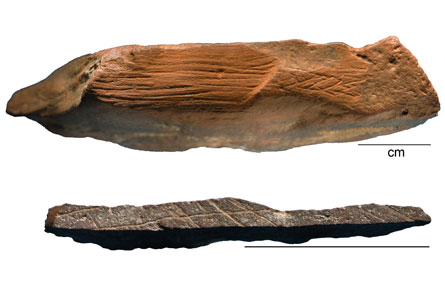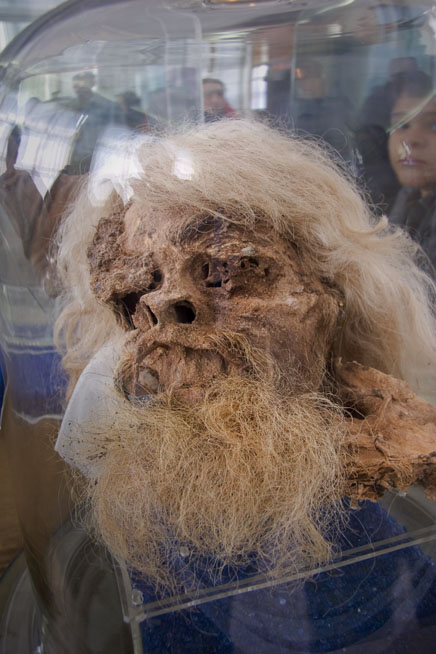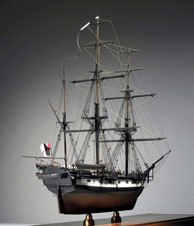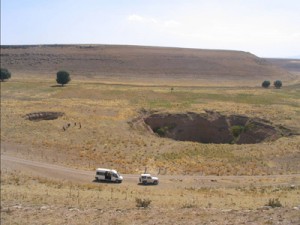Engraved pigments point to ancient symbolic tradition
Scientists excavating a Stone Age cave on South Africa’s southern coast have followed a trail of engraved pigments to what they suspect are the ancient roots of modern human behavior.
Analyses of 13 chunks of decorated red ochre (an iron oxide pigmen from Blombos Cave indicate that a cultural tradition of creating meaningful geometric designs stretched from around 100,000 to 75,000 years ago in southern Africa, say anthropologist Christopher Henshilwood of the University of the Witwatersrand in Johannesburg and his colleagues.
“What makes the Blombos engravings different is that some of them appear to represent a deliberate will to produce a complex abstract design,”Henshilwood says. “We have not before seen well-dated and unambiguous traces of this kind of behavior at 100,000 years ago.”
A microscopic analysis indicates that ochre designs were made by holding a piece of pigment with one hand while impressing lines into the pigment with the tip of a stone tool. On several pieces, patterns covered areas that had first been ground down.
Geometric patterns on the ochre pieces include cross-hatched designs, branching lines, parallel lines and right angles.Pigment powder had also been removed from many of the recovered ochre chunks. Incised patterns may have served as models for pigment designs applied to animal skins or other material, the scientists speculate.
Geometric patterns incised on pieces of ancient pigment, such as these 100,000-year-old finds, may reveal the surprisingly ancient origins of modern human behavior.
Mummified salt men of Iran shifted to archaeological museum:
In the last 10 years 6 Iranian mummies (salt men) have been unearthed at the Chehrabad Salt Mine in the Hamzehlu region near Zanjan, Iran.
Four salt men were kept at the Rakhtshuikhaneh Meseum
in Zanjan.
Due to insufficient funds there were no permanent cases to preserve the salt men. The plexiglass designed for the salt men were not sealed air tight. Changes in the temperature have created cracks in the case and have allowed bacteria to enter. Though the damages are not visible to the naked eye, the bacteria are damaging the internal organs.
Studies on the salt men reveal
First salt men – 1700 years old (Died at the age of 30-40)
Fourth salt men – 2000 years old ( Died at the age of 12-13)
Other salt men – unknown
The Sixth Salt Man – left in place due to the lack of equipment necessary for its preservation in Iran.
According to Manijeh Hadian, studies have been completed for making permanent cases for the salt men. Now the necessary funds should be found for making the devices which will preserve the Iranian mummies in a more efficient way.
Inspite of all the insufficient funding the four muumies are now placed inside the windows of hygroscopic glass at the Zanjan Archaeology Meseum.
Abolfazl Aali said that “Except the First Salt Man which is on display at the National Museum of Iran in Tehran, the other four are put on display at Zanjan Archaeology Meseum“.
New discovery at in the Tomb of Djehuty
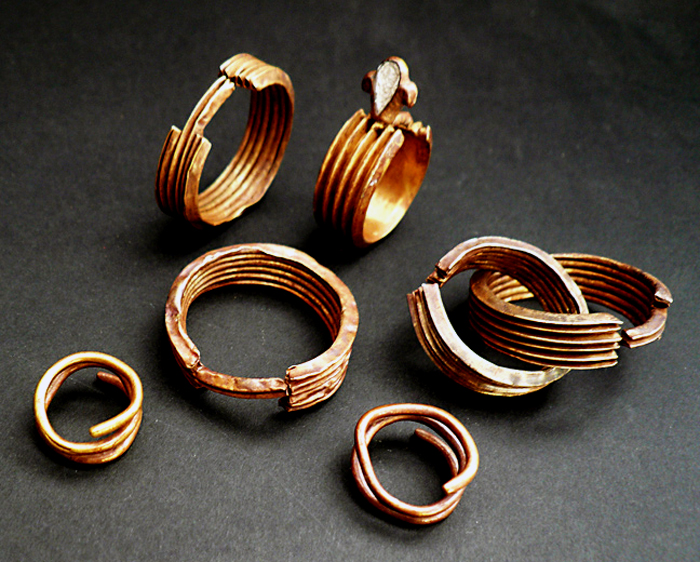
Jewelry 3500 years old
A Spanish mission working at Dra Abu El-Naga on the West Bank at Luxor found ancient jewelry in Djehuty’s tomb. The jewelry belonged to Djehuty himself or a member of his family which dates back to mid 18th dynasty (around 3500 years ago.).
Djehuty was the state overseer of treasury and overseer of works during the reign of Queen Hatsheput. The tomb is decorated and painted with texts from the Book of the Dead along with a huge painting of Goddess Nut. The discovery is important as only four other decorated burial chambers of this period are known. There were 5 gold ear rings and two gold rings which are approximately 3500 years old.
Major exhibition at Australian National Maritime Museum
A major exhibition coming to the Australian National Maritime Museum which will take visitors on the sea voyage by Charles Darwin and his crew that inspired great theory of evolution.
The young scientist navigated around the globe on his HMS Beagle between 1831-1836. The exhibition to be held in the Australian National Maritime museum from March 20-23 will bring this voyage to life.
Features of the exhibition:
• Introduction to his companions overboard
• What they saw
• Ship plans
• Charts and documents used in the voyage
• Portraits of some of the people on board
• Types of scientific instruments used on Beagle
• A mock-up of Darwin’s cabin
• Pictures of landfalls
• Pictures of people the crew met along their way
• Original Specimens from his natural history collection – crustacean
• Darwin’s studies
• His life with his family in his village Downe, Kent
• Real glass house which demonstrates his interest for orchids
• Scientific study of their reproduction
Archaeological Study of a Limestone Sinkhole:
In partnership with the East National Park of the Dominican Republic, a team of archaeologists and scientists led by Charles D.Beeker of Indiana University has provided an initial evaluation of a mysterious sinkhole in the tropical jungle. During three separate expeditions in 1996, the team was able to penetrate and document the archaeological potential of El Manantial de la Aleta, a deep, fresh water well containing a rich deposit of Taino artifacts.
This site has been an important landscape feature for many centuries. It is thought to be the water source described by the chronicler Bartoleme de Las Casas in the first decade of the sixteenth century for the capital village
of Cotubanama, the Taino cacique. This site and its people were destroyed in a bloody war with the Spaniards in 1503.
The La Aleta site lies deep in the jungle of East National Park far from any established roads. There is a trail which can be taken from Boca de Yuma through La Granchorra, but it is very difficult. The team assembled several
tons of diving supplies and equipment needed to conduct the archaeological study. Some items were transported by mule over a 7 hour trail. Other materials and team members were flown by helicopter to the site. The first order of business was to get to the water. The manantial, or sinkhole, is reached by a descent of 50 feet through a small opening in the limestone rock. A rope system was rigged to allow access and equipment to reach the water. A 14 foot Quicksilver inflatable was launched and served as a diving platform for the operation.
La Aleta proved to be a spectacular dive. It has crystal clear water at the surface, but at a depth of 35 feet, a sulfur layer is encountered. This mixture continues to a depth of 65 feet, where fresh water again takes over. The bottom is at a depth of 115 feet. Here a cap rock, part of the collapsed formations from above, serves as a datum for the site. Thick humus silt containing a variety of artifacts, surrounds the cap rock. The deposit slopes to great depth — at least 240 feet in every directions.
